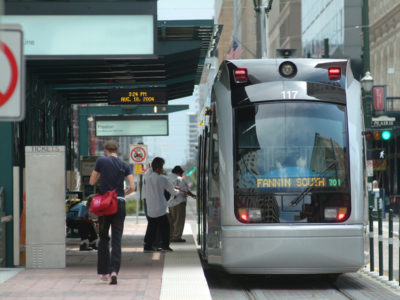
TTI researchers Tony Voigt, Mike Vickich and Micah Montoya received U.S. patent no. 10,535,262 on Jan. 14, 2020, for an active pedestrian warning system for rail and bus transit routes. Pedestrians distracted near vehicles on the road are at risk for injuries and fatalities in the event of a collision. Both drivers and pedestrians are responsible for safety on the road, but for example, a train’s operator may not be able to stop the train in time to avoid an impact.
The active pedestrian warning system uses a Bluetooth® beacon transmitter synced up with a vehicle, such as a train or a bus. The transmitter picks up mobile devices nearby, determines which devices are relevant (given a set of criteria), and sends an audible, visual or tactile (or all three) alert to the mobile devices. Receiving this alert on their mobile device, a pedestrian could realize they’re about to walk in front of a bus, for example, and look up in time to avoid an unnecessary collision.
“The Bluetooth Proximity Alert System can be used by transit agencies to enhance safety for pedestrians and bicyclists by raising awareness of approaching transit vehicles. It’s also relatively simple to implement, making it an attractive tool for the safety toolbox,” says Vickich.
Vickich and TTI researcher Darryl Puckett received U.S. patent no. 10,726,717 on July 28, 2020, for a traffic monitoring system used on roadways in real-time. Transportation agencies operating roadway networks are interested in improving processes for collecting and analyzing traffic data. Traditionally, these agencies use toll tags or license plate recognition to collect data, but these methods are often costly and involve privacy issues for the traveling public.
The traffic monitoring system uses multiple reader devices that pick up wireless signals from devices — such as mobile phones — in vehicles within the reader device’s range. Each reader device categorizes a vehicle with a time stamp, which is sent to a centralized location. The system compares each reader device’s time stamp for a vehicle to other time stamps associated with that vehicle. This method provides a way to gather data in real-time and determine how to make improvements to travel time accuracy. With this kind of data, transportation agencies can access more accurate information on traffic data for near real-time reporting and planning purposes.
Puckett comments, “This application has been implemented in more than 5,000 specific locations worldwide since its development. It’s widely regarded as state-of-the-art for traffic monitoring and continues to evolve with additional improvements as technology changes.”